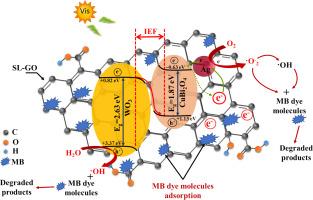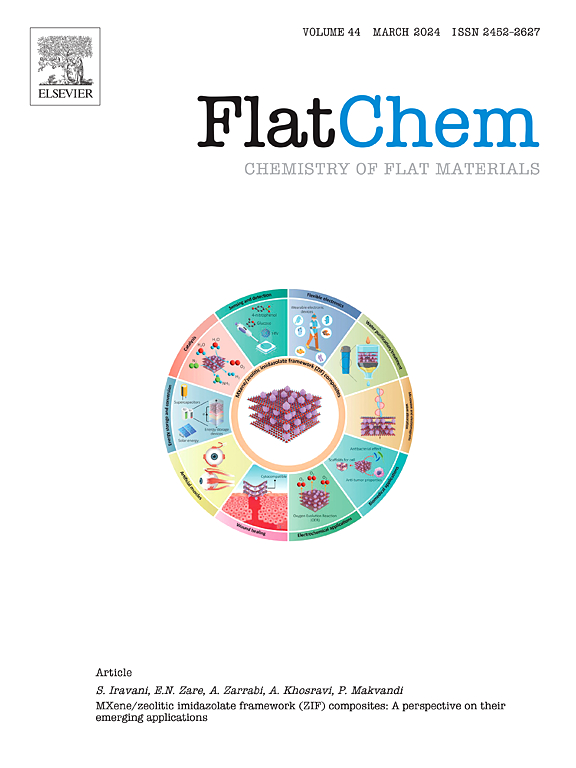Enhanced adsorption-photocatalysis of organic pollutants using an Ag-CuBi2O4/WO3/SL-GO nanocomposite
IF 6.2
3区 材料科学
Q2 CHEMISTRY, PHYSICAL
引用次数: 0
Abstract
Water pollution poses a serious threat to ecosystems and human health, requiring effective and sustainable treatment strategies. While conventional methods often fall short, there remains a significant research gap in developing highly efficient hybrid systems that combine enhanced adsorption with potent visible light photocatalysis. Herein, we report the novel synthesis of a unique 1D/0D/2D heterostructure photocatalyst, which consists of Ag-modified CuBi2O4 nanorods and WO3 nanoparticles decorated on single-layer graphene oxide (SL-GO) sheets, targeting both significantly enhanced methylene blue (MB) adsorption and photodegradation. The Ag-CuBi2O4/WO3/SL-GO nanocomposite was synthesized via combined hydrothermal/ultrasonication methods. XRD, SEM, EDX, FTIR, XPS, PL, and Raman techniques confirm its successful preparation. The analyses demonstrated a substantial enhancement in MB adsorption and near-complete MB photodegradation (99.5 %) under visible light, with a notably high kinetic rate constant (0.0319 min−1). Its adsorption capacity was also 4–10 times larger than that of individual components and binary nanocomposite material. The enhanced performance is primarily ascribed to the reduced band gap, high surface area and exceptional electron conductivity of SL-GO, efficient charge separation, reduced electron-hole recombination, enhanced visible light absorption capacity, and synergistic integration of Ag-CuBi2O4/WO3 and SL-GO features. In addition, the nanocomposite was non-genotoxic, which assures its safe use in environmental applications. This study presents a promising and low-energy approach for water remediation, highlighting the potential of the hybrid Ag-CuBi2O4/WO3/SL-GO photocatalyst for sustainable environmental applications and can guide future designs for the removal of diverse pollutants.

Ag-CuBi2O4/WO3/SL-GO纳米复合材料增强对有机污染物的吸附-光催化作用
水污染对生态系统和人类健康构成严重威胁,需要有效和可持续的治理战略。虽然传统的方法往往不足,但在开发高效的混合系统方面仍然存在重大的研究差距,该系统将增强吸附与强可见光催化相结合。在此,我们报道了一种独特的1D/0D/2D异质结构光催化剂的新合成,该催化剂由ag修饰的CuBi2O4纳米棒和WO3纳米颗粒组成,装饰在单层氧化石墨烯(ls - go)片上,旨在显著增强亚甲基蓝(MB)的吸附和光降解。采用水热/超声复合法制备了Ag-CuBi2O4/WO3/SL-GO纳米复合材料。XRD, SEM, EDX, FTIR, XPS, PL和Raman技术证实了其成功制备。分析表明,在可见光下,甲基溴的吸附和近乎完全的甲基溴光降解(99.5%)显著增强,动力学速率常数显著提高(0.0319 min−1)。其吸附量也比单组分和二元纳米复合材料大4-10倍。这种增强的性能主要归因于SL-GO的带隙减小、高表面积和优异的电子导电性、有效的电荷分离、减少的电子空穴复合、增强的可见光吸收能力以及Ag-CuBi2O4/WO3和SL-GO的协同集成特性。此外,纳米复合材料无基因毒性,这保证了其在环境应用中的安全使用。该研究提出了一种有前途的低能耗水修复方法,突出了Ag-CuBi2O4/WO3/SL-GO混合光催化剂在可持续环境应用中的潜力,并可以指导未来设计去除各种污染物的方法。
本文章由计算机程序翻译,如有差异,请以英文原文为准。
求助全文
约1分钟内获得全文
求助全文
来源期刊

FlatChem
Multiple-
CiteScore
8.40
自引率
6.50%
发文量
104
审稿时长
26 days
期刊介绍:
FlatChem - Chemistry of Flat Materials, a new voice in the community, publishes original and significant, cutting-edge research related to the chemistry of graphene and related 2D & layered materials. The overall aim of the journal is to combine the chemistry and applications of these materials, where the submission of communications, full papers, and concepts should contain chemistry in a materials context, which can be both experimental and/or theoretical. In addition to original research articles, FlatChem also offers reviews, minireviews, highlights and perspectives on the future of this research area with the scientific leaders in fields related to Flat Materials. Topics of interest include, but are not limited to, the following: -Design, synthesis, applications and investigation of graphene, graphene related materials and other 2D & layered materials (for example Silicene, Germanene, Phosphorene, MXenes, Boron nitride, Transition metal dichalcogenides) -Characterization of these materials using all forms of spectroscopy and microscopy techniques -Chemical modification or functionalization and dispersion of these materials, as well as interactions with other materials -Exploring the surface chemistry of these materials for applications in: Sensors or detectors in electrochemical/Lab on a Chip devices, Composite materials, Membranes, Environment technology, Catalysis for energy storage and conversion (for example fuel cells, supercapacitors, batteries, hydrogen storage), Biomedical technology (drug delivery, biosensing, bioimaging)
 求助内容:
求助内容: 应助结果提醒方式:
应助结果提醒方式:


